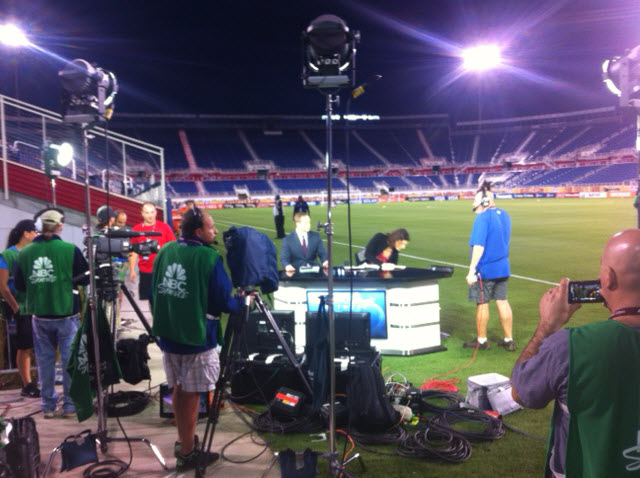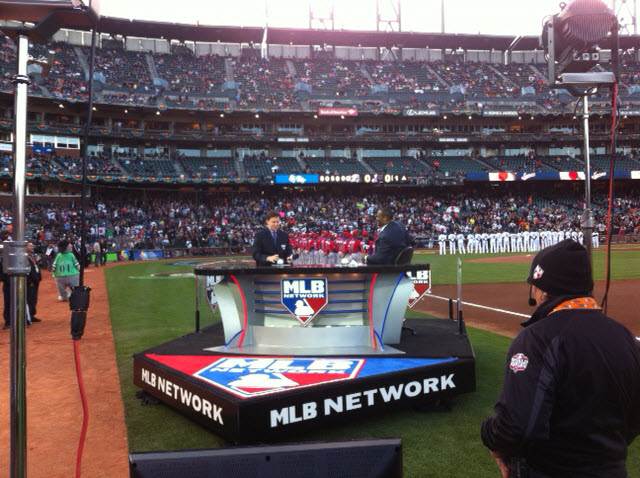As seen in the Lighting Dimensions, July 2003 Issue:
The business of lighting major live events, which are also televised around the world, is stressful enough. But for Frank Gatto & Associates, the Mike Tyson –Clifford Etienne heavyweight boxing extravaganza took on the air of a one-ring circus. Throughout his career, Tyson has been an enigma. He was a world champion, the possessor of a devastating punch that sent most opponents into next week. Then came six years in prison for rape. Afterward, there was his comeback, which included incredible exhibitions of poor judgment or just pure insanity, including the removal of a chunk of Evander Holyfield’ s right ear with his teeth.
Through it all, lighting designer Frank Gatto has not been far away. Having worked over 1,000 professional boxing matches, Gatto and his crew are usually ready for anything. The most recent was probably one of the most frustrating. The Memphis fight against Etienne in late February was thrown into turmoil when Tyson failed to make the flight from his home in Las Vegas not once, but twice. His trainers claimed Tyson was either sick or suffered from affects of a huge facial tattoo.
How does this affect an experienced lighting company like Frank Gatto & Associates? Do they “green light” the semi-trailer truck full of lighting equipment inbound from New Jersey when no one knows if Iron Mike will get to Memphis at all? Once you’ ve rented all that stuff, you’ ve got to pay for it, whether you use it or not. Gatto has to keep his supplier, Circuit Lighting, on hold. He has worked with the company for ten years and considers them on of the best in the business. So, what does Gatto do?
Gatto and right-hand man George Smith, crew chief Jason Eible, and an IATSE crew of three riggers and six stagehands did arrive on schedule and jumped to the task of hanging lights over the boxing ring, the audience, and broadcast positions at the Pyramid Arena in Memphis. Eible coordinated the crew assignments and followed Gatto’ s lighting design plots, carrying out the plans that had been previously discussed.
The lighting grid for the ring and audience was extensive: Seventy-two 575Wt ETC Source Four Pars and 24 High End Systems Studio Colors. Also lighting the audience were forty-eight 575 Source Four Pars many in color, to separate the crowd from the main focus of the ring. Also used were 12 Source Four Ellipsoidals to light the banners. The locker rooms were a challenge because Tyson does not allow cameras inside his space. The solution was to light the dark hallway leading to his locker room with a sun-gun on the live hand-held video camera and catch him walking in. Additional light was provided by eight Source Four Pars bounced it the white ceiling. Eteinne did allow access to his room, so three Source Four Pars were installed, again bounced off the ceiling.
The following steps are part of virtually every boxing match that Gatto lights. Gatto and Smith meet with the television directors for (in this case) Showtime network to decide where broadcast location will be, ensuring the position is in the balcony to give the overview effect for the on-air talent. The key here is making sure the there’ s a proper amount of “TV” lights in relationship to the event lighting. Most of the time there is a backlight to highlight the anchors, who wear black tuxedos. Without that “ace’ light they can get lost in the dark background. Gatto knows that lower-power small lights set closer to the talent give the best results in softer lighting. The best options are no more than 175fc, which is similar to the level in the ring, using a 1K fresnel for a key light, a 500W Fresnel as a back light, and a 1,000W fixture with a chimera.
Gatto is especially particular about shadows. “You never want to have harsh shadow,” he says. “I use a Gam 65 [Medium Gam Silk] or Rosco 104 [Tough Silk] in every ring light to soften it; that allows me to make transitions to different lighting zones in the ring.” He uses a fusion technique to soften the space between each light, resulting in a smoother transition. He uses his trusty light meter in all areas of the ring to check for shadows, he adds: “I do this by walking around ring with my meter. Then I back the dimmers off to 80% to soften even more in the ring. It also cools dimmers down, preventing overheating.”
Smith works closely with the TV director and cameramen including looking through the eyepiece of each camera to get a clear view of how the lighting looks on TV. This is especially true with the “jib” camera operator, which operates at ringside and moves extensively. Smith then gives the director different “looks” from a lighting perspective, confirms the sequences and enters them into the computer lighting program. “You never want to have same amount of light in ring as on the audience,” says Gatto. “We put a slightly amber tone light on the audience at half the intensity level, then we fade it lightly as you go back…the key is not to draw attention away from ring.”
Beauty lights, when focused towards a camera lens, will create a star filter effect, which has been very popular over the years. Their placement and the selection of colors can create a signature look for a series. “We were the first to use moving lights in boxing, says Gatto.“ In our first experiment, we used four moving lights and mixed them with stationary beauty lights. In comparing the two, the moving lights looked much better and could be focused to different camera positions, cutting down on the number of fixtures. We decided as a team to use all moving lights as beauties. “
One day out from the event, both Gatto and Smith spend the entire day focusing & fine-tuning all the different lighting “looks”. Smith continues programming; Gatto works on the “host” broadcast position high up in the grandstand where play-by-play anchor Nick Charles will work. A fighter’ s “walk-in” is a classic part to boxing, and Gatto wants something special. It might be the most exciting part of the broadcast.
In the history of boxing there have been heavyweight championship fights that had to be discontinued because of a power failure, so Gatto and his team always have a backup plan. On three occasions during Gatto’ s career he has lost power, the longest being for 10 minutes. For this event, half the ring lights were on land power and generator and half the ring lights were on another source of land power and another generator with switching capabilities. Five unlikely events would have had to happen before the lights would be lost. Even then, lighting crew members were on headset with the house and the venue’ s basketball lights could be used if necessary; also, another emergency generator could be started, which would take us about 49 seconds (ironically, the length of this fight).
Gatto believes the day of the event is usually the easiest part of the process. The preparation and the set-up and rehearsals are generally much harder, probably because producers and directors have time to change things. The lighting crew is in at 2pm for an 8pm event. They again check everything and make any adjustments needed.
Then, as veteran ring announcer Jimmy Lennon would say, it’ s Showtime! This time, the show went off without a hitch and after all that work. Tyson (facial tattoo and all) disposed of Etienne in just 49 seconds. Another one bites the dust!
Eric Moffitt







